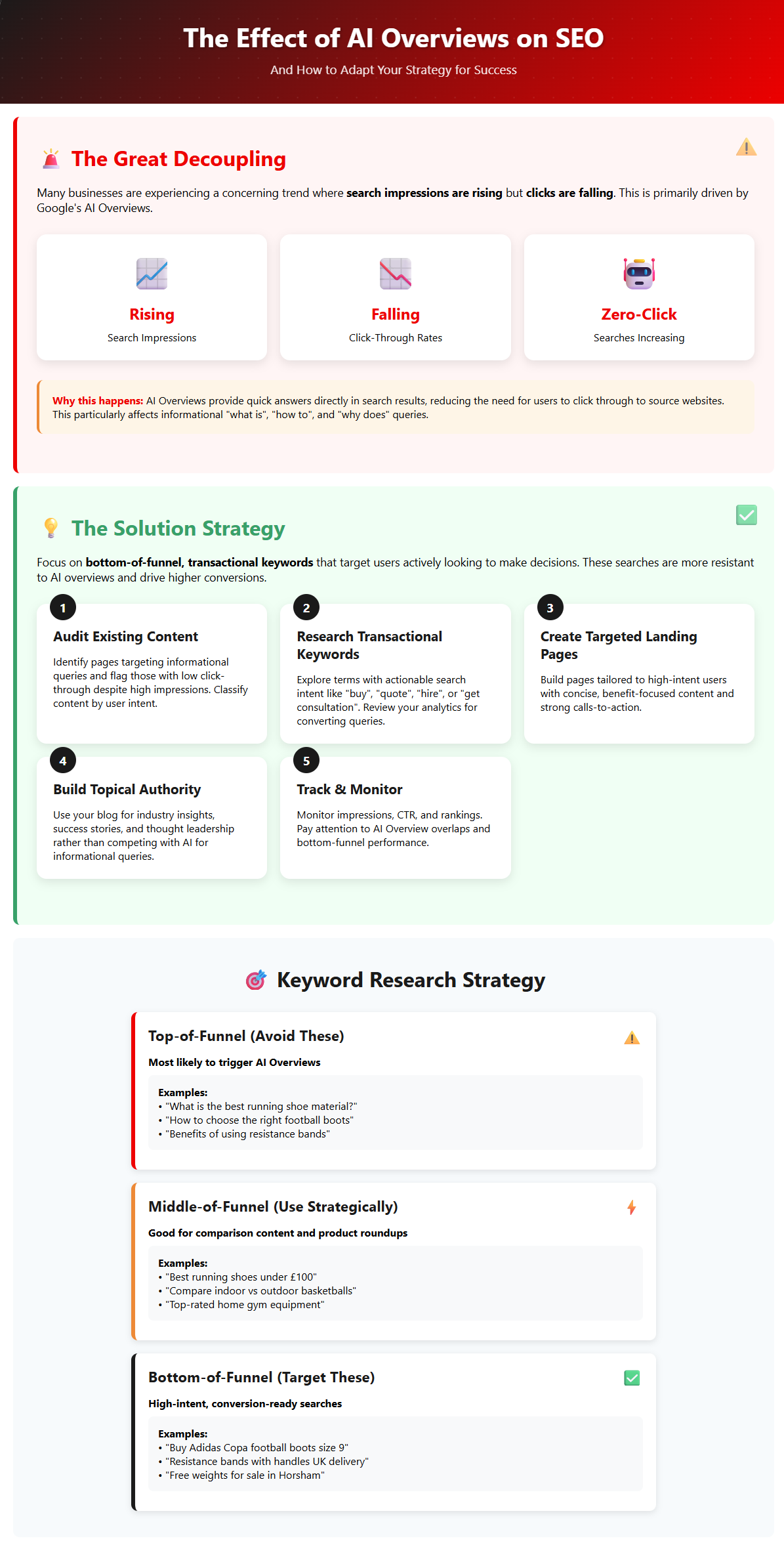Many businesses are witnessing a performance trend where their website’s search impressions are rising, yet their clicks are falling. This phenomenon – referred to as the ‘Great Decoupling’ – is primarily driven by Google’s AI Overviews.
These AI-generated summaries appear directly in the search results, pulling content from websites to offer quick answers for users. As a result, users can find what they need without clicking through to the source websites, increasing zero-click searches. For brands that rely on organic traffic to boost business, the impact is significant and concerning.
In this guide, we’ll focus on the effect of AI Overviews on SEO and look at how businesses can counter this impact with an SEO strategy for the age of AI-powered search.
At britweb, we’re ready to help. Call us on 01403 261491 to book a free consultation. It’s important to be proactive and find the right SEO solutions for your business.

The SEO shift caused by Google’s AI Overviews
- AI Overviews reduce clicks to source websites
- Most keywords that trigger AI Overviews are informational
- Targeting top-of-funnel keywords is increasingly ineffective
Google’s AI Overviews are part of the brand’s rollout of AI-driven search. Its responses compile data from several online sources, structured in a conversational way, and feature prominently above traditional web listings in the organic search results.
Traditional search engine optimisation tactics focused on ranking for top-of-funnel queries (broad, informational search terms, ‘what is’, ‘how to’, or ‘why does’) are increasingly ineffective. As AI Overviews provide concise answers to these types of queries, it reduces the need for users to visit external sites, negatively affecting organic visibility and ad revenue.
Unlike featured snippets, which link to one source, AI Overviews blend AI-generated content from several providers, sometimes without clear attribution.
What is the solution for impacted businesses?
- Focus on bottom-of-the funnel, transactional keywords
- Target users who are actively looking to make a decision
If your business sees search impressions rise but clicks decline, you’re likely targeting too many informational keywords, precisely the type of queries that Google’s AI Overviews now answer directly in the search results. The good news is there’s still a strong opportunity to gain qualified traffic by shifting focus to bottom-of-funnel, transactional keywords (high-intent, transactional search terms like ‘buy’, ‘hire’, ‘get a quote’, or specific product/service names).
These are the search queries used by people who already know what they want and are actively looking to make a decision, whether it’s booking a service, making a purchase, or finding a provider. These searches still demand user engagement with websites, making them far more resistant to AI overviews and zero-click trends.
To begin putting this strategy into action, a business must identify opportunities and reshape content. Here’s a step-by-step look at this process:
Audit your existing content
The first step is to assess your current website to understand the impact of AI Overviews. This begins by auditing your site’s content to find which pages are driving value and which are vulnerable to displacement by AI-generated answers.
- Identify blog posts or landing pages targeting top-of-funnel informational queries.
- Flag pages with low click-through despite high impressions – these likely overlap with AI-generated summaries.
- Classify content by user intent: Are your pages trying to inform, or are they designed to convert?
A review like this will help inform the best ways to refine your SEO strategy toward more durable, transactional queries.
Research transactional keywords relevant to your business
To recover from any declining search traffic, uncover bottom-of-funnel keywords with strong purchase intent. These keywords are less likely to trigger AI Overviews and more likely to result in conversions.
- Explore terms that reflect actionable search intent, such as buy, quote, hire, or get a consultation.
- Review search volume, competitive metrics, and overview data that show where gaps exist.
- Look at your own Google Search Console and analytics data for queries that already bring in converting users.
This research will help find opportunities and steer your content toward more qualified traffic.

Create landing pages targeting transactional keywords
When valuable bottom-of-funnel keywords have been found, the next step is to turn those insights into highly targeted landing pages. These pages should be tailored to users who are ready to take action, whether that’s making a purchase, booking a consultation, or requesting a quote.
An effective transactional landing page can include:
- The target keyword in the page title, URL slug, and H1 heading
- The keyword placed early in the copy/first sentence
- Concise, benefit-focused content (not long-form blog content)
- A strong, action-driven call to action (e.g. Get Your Free Quote, Book Now, or Buy Today)
- Meta descriptions and image alt text supporting the keyword
- Structured data to help Google understand the context
Pages designed this way tend to convert more effectively because they meet the immediate needs of high-intent users. They also rank more quickly, as transactional keywords often face less competition than broad informational terms. Unlike long-form blog content, these landing pages require less ongoing investment and typically remain evergreen, continuing to drive results without frequent updates.
Use your blog to focus on topical authority
Rather than competing with AI-powered search for top-of-funnel visibility, businesses can use their blog to focus on building topical authority and strengthening their brand presence.
A blog can be used to:
- Share industry news, updates, and commentary
- Publish customer success stories
- Announce company milestones or events to reinforce brand personality
- Discuss trends or technologies, demonstrating thought leadership and niche expertise
This type of content doesn’t just add depth to your website; it shows Google’s AI systems and traditional search engines that your business has real-world relevance and experience. Over time, this supports your site’s E-E-A-T (Experience, Expertise, Authority, and Trustworthiness) signals.
By shifting your blog away from informational keywords and towards authority building, you create long-term value that’s harder for AI to replicate and easier for real users to engage with.
Track and monitor performance
To understand how AI Overviews affect your site and the success of your strategy as it evolves, use analytics tools to track changes in impressions, click-through rates, and keyword rankings. Pay close attention to which queries overlap with AI Overview results and how your bottom-of-funnel landing pages perform compared to informational content.
Ongoing monitoring will allow you to adapt your optimisation strategy as Google’s generative AI develops over time, ensuring your content continues to deliver value and visibility.
How to focus keyword research effectively
As shown, keyword research is essential to this approach, and creating an effective SEO strategy in the age of AI-powered search depends on mapping keywords to the buyer’s journey and identifying those with substantial transactional value.
Here’s how this applies using a familiar topic like sports equipment:
Top-of-Funnel (Most likely to trigger AI Overviews)
- What is the best running shoe material?
- How to choose the right football boots
- Benefits of using resistance bands
These queries carry informational intent and are most likely to be satisfied by AI Overviews without sending traffic to your website.
Middle-of-Funnel (Use these strategically)
- Best running shoes under £100
- Compare indoor vs outdoor basketballs
- Top-rated home gym equipment
Use these for comparison content or product roundups on structured landing pages.
Bottom-of-Funnel (Target these high-intent keywords)
- Buy Adidas Copa football boots size 9
- Resistance bands with handles UK delivery
- Free weights for sale in Horsham

These terms reflect purchase-ready search intent, helping you attract users actively looking to convert. They’re far more resistant to disruption by AI-generated summaries.
Get in touch
The evolution of Google Search Results is just beginning. As AI systems continue to refine how they deliver information, brands that focus on transactional queries, user intent, and structured landing pages will gain an advantage.
At britweb, we have the skills to help you navigate this shift and stay ahead of the AI curve.


